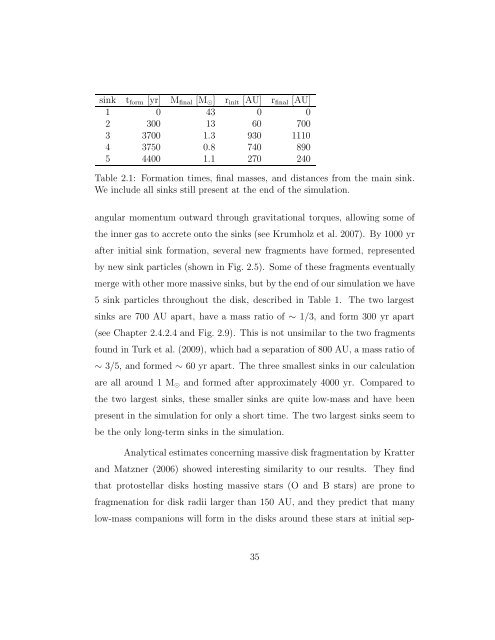Copyright by Athena Ranice Stacy 2011 - The University of Texas at ...
Copyright by Athena Ranice Stacy 2011 - The University of Texas at ...
Copyright by Athena Ranice Stacy 2011 - The University of Texas at ...
Create successful ePaper yourself
Turn your PDF publications into a flip-book with our unique Google optimized e-Paper software.
sink tform [yr] Mfinal [M⊙] rinit [AU] rfinal [AU]<br />
1 0 43 0 0<br />
2 300 13 60 700<br />
3 3700 1.3 930 1110<br />
4 3750 0.8 740 890<br />
5 4400 1.1 270 240<br />
Table 2.1: Form<strong>at</strong>ion times, final masses, and distances from the main sink.<br />
We include all sinks still present <strong>at</strong> the end <strong>of</strong> the simul<strong>at</strong>ion.<br />
angular momentum outward through gravit<strong>at</strong>ional torques, allowing some <strong>of</strong><br />
the inner gas to accrete onto the sinks (see Krumholz et al. 2007). By 1000 yr<br />
after initial sink form<strong>at</strong>ion, several new fragments have formed, represented<br />
<strong>by</strong> new sink particles (shown in Fig. 2.5). Some <strong>of</strong> these fragments eventually<br />
merge with other more massive sinks, but <strong>by</strong> the end <strong>of</strong> our simul<strong>at</strong>ion we have<br />
5 sink particles throughout the disk, described in Table 1. <strong>The</strong> two largest<br />
sinks are 700 AU apart, have a mass r<strong>at</strong>io <strong>of</strong> ∼ 1/3, and form 300 yr apart<br />
(see Chapter 2.4.2.4 and Fig. 2.9). This is not unsimilar to the two fragments<br />
found in Turk et al. (2009), which had a separ<strong>at</strong>ion <strong>of</strong> 800 AU, a mass r<strong>at</strong>io <strong>of</strong><br />
∼ 3/5, and formed ∼ 60 yr apart. <strong>The</strong> three smallest sinks in our calcul<strong>at</strong>ion<br />
are all around 1 M⊙ and formed after approxim<strong>at</strong>ely 4000 yr. Compared to<br />
the two largest sinks, these smaller sinks are quite low-mass and have been<br />
present in the simul<strong>at</strong>ion for only a short time. <strong>The</strong> two largest sinks seem to<br />
be the only long-term sinks in the simul<strong>at</strong>ion.<br />
Analytical estim<strong>at</strong>es concerning massive disk fragment<strong>at</strong>ion <strong>by</strong> Kr<strong>at</strong>ter<br />
and M<strong>at</strong>zner (2006) showed interesting similarity to our results. <strong>The</strong>y find<br />
th<strong>at</strong> protostellar disks hosting massive stars (O and B stars) are prone to<br />
fragmen<strong>at</strong>ion for disk radii larger than 150 AU, and they predict th<strong>at</strong> many<br />
low-mass companions will form in the disks around these stars <strong>at</strong> initial sep-<br />
35









